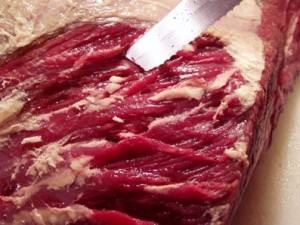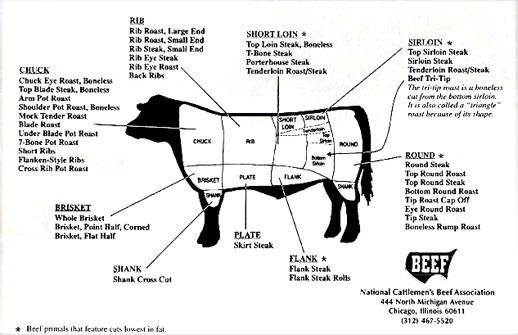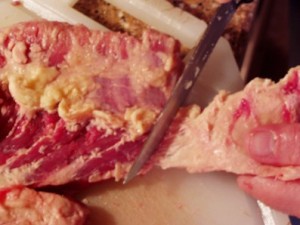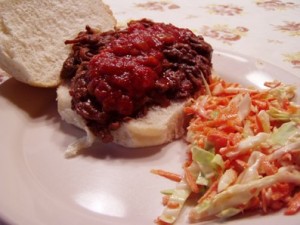 Aunt Toby believes that one of the problems with cooking in these United States is that we get stuck in a rut. We cook something because Mom and Dad cooked it or because we are familiar with it. Frankly, there are meat cuts out there that 99% of American’s have never eaten; never experienced in the kitchen, and frankly are scared to death of.
Aunt Toby believes that one of the problems with cooking in these United States is that we get stuck in a rut. We cook something because Mom and Dad cooked it or because we are familiar with it. Frankly, there are meat cuts out there that 99% of American’s have never eaten; never experienced in the kitchen, and frankly are scared to death of.
Here, for your delectation, is a chart showing, cleverly enough, a beef with all the cuts diagrammed out for you.  Lots there that you have not eaten, I’m sure. But starting at the front end, just above the leg, there is a cut that frankly a lot of Americans are familiar with, in various permutations, and we’re going to discuss a few things with that here. This is the brisket.
Lots there that you have not eaten, I’m sure. But starting at the front end, just above the leg, there is a cut that frankly a lot of Americans are familiar with, in various permutations, and we’re going to discuss a few things with that here. This is the brisket.
If this animal were a lamb, it would be referred to as the ‘breast’. In beef, this is also referred to as the flank. If you recall your human anatomy and gaze down at your own chest, you will recall that this area has long strappy muscles on it. Check the photo at the top – those meat fibers are all long and in general all run parallel to one another. In general, this makes this particular cut, unless you prepare it under certain conditions, extremely chewy and stringy. Two things will make it less chewy: cutting across the fibers at a 90-degree angle (like slicing London Broil) and/or cooking slowly with moisture. It’s a cut that can be prepared in all sorts of ways which take advantage of it’s inherent qualities, such as:
Corned beef. You can use other cuts but the brisket is the best.
Pastrami. Ditto
Flank steaks, London Broil, etc.
Pot roast.
Slow cooked, pulled apart dishes such as bbq, the Spanish dish “old clothes”, and other ethnic dishes. In my household, my father referred to it as ‘gedempte fleisch’ which means, in Yiddish, “boiled meat’.
You bet.
But first, let’s imagine what one of these babies looks like. If you have bought a corned beef brisket, you have a pretty good idea of what at least a section of a beef brisket looks like – usually triangular shaped, and usually with a lot of fat on it. Some of the fat is hard; and some of the fat is really sort of spongy. When you work with brisket, you want to trim off as much of that as possible, but again, in working with a muscle group like this, there are membranes running all over the top between the meat itself and the fat and you want to not only trim off as much of the fat as you can but also you want to get the membranes off because those make the meat chewy also.
 First, get off as much fat simply by taking a knife and cutting it off, getting as close to the meat as possible there are going to be places, especially where the fat is spongy, where this is going to get a little bit dicey. What you do then, is (see the photo), grab one end of a piece of fat and membrane in your non-dominant hand and start to pull toward that hand. Taking the knife in your dominant hand, start cutting as close to the meat as possible, separating the fat and membranes from the meat itself. You’ll find that sometimes, the pulling will go easily; and sometimes it won’t. Take your time and be careful. The point of this is to get as much of this off as possible. If you are the sort of person who feeds birds – load all of this up into a dutch oven and cook it down, skim off anything that floats and then cool it and package it up for the freezer for suet blocks for the birds next winter.
First, get off as much fat simply by taking a knife and cutting it off, getting as close to the meat as possible there are going to be places, especially where the fat is spongy, where this is going to get a little bit dicey. What you do then, is (see the photo), grab one end of a piece of fat and membrane in your non-dominant hand and start to pull toward that hand. Taking the knife in your dominant hand, start cutting as close to the meat as possible, separating the fat and membranes from the meat itself. You’ll find that sometimes, the pulling will go easily; and sometimes it won’t. Take your time and be careful. The point of this is to get as much of this off as possible. If you are the sort of person who feeds birds – load all of this up into a dutch oven and cook it down, skim off anything that floats and then cool it and package it up for the freezer for suet blocks for the birds next winter.
Now that you have a trimmed cut of meat, you can actually do something with it. This post is about making pulled BBQ Beef using a crock pot.
Ingredients:
Trimmed beef brisket, several pounds, cut into large chunks.
1-2 cans of low sodium beef broth
a couple of dried bay leaves
a teaspoon of black pepper corns
Put the chunks of brisket into the crock pot with the bay leaves and the pepper corns and enough broth so that it comes within an inch of the top of the meat. Don’t drown the meat.
Put the crock pot on high for one hour, then lower to low for 8 hours (this is really great done at night)
After 8 hours (or in the morning, whichever comes first), take the meat out, put into a bowl. Take two forks and shred up the meat. Store in a covered container in the fridge for later
Take the liquid in the crock pot, allow to cool, and put into a container in the fridge.
Just before you make the bbq sauce later on, take the container out, take the fat off the top and put the jellied liquid underneath back into the crock pot (I’m going to assume that you washed it this morning..).
Add half the bbq sauce to this in the crock pot and add the meat back. Put the crock pot on high to reheat.
Serve on toasted buns (make sure they are some sort of bun with a crunchy crust) with cole slaw.
 BBQ Sauce: There are all sorts of bbq sauce recipes out there. Unfortunately, a lot of them start with ‘take a bottle of xxx bbq sauce’. This is a recipe from home ingredients, tastes great and you know it won’t have anything like corn syrup or high fructose corn syrup in it.
BBQ Sauce: There are all sorts of bbq sauce recipes out there. Unfortunately, a lot of them start with ‘take a bottle of xxx bbq sauce’. This is a recipe from home ingredients, tastes great and you know it won’t have anything like corn syrup or high fructose corn syrup in it.
Ingredients:
1 large (14 oz.) can of crushed tomatoes
1/2 cup of finely minced onion, cooked in 2 tablespoons of olive oil
3 tablespoons of brown sugar (you can also use honey)
3 tablespoons of vinegar
4 cloves of garlic, crushed
2 table spoons of light soy sauce
2 teaspoons of dry mustard
(if you like really spicy bbq sauce, add 2 teaspoons of cayenne pepper; you can always adjust for you own taste by adding less however)
Prep:
Cook minced onion and garlic in the olive oil until the onions turn opaque. Add remaining ingredients and allow to simmer until blended.
Holding back 1-2 cups of the sauce for table use, take the rest of the sauce and put that into the crock pot with the shredded meat and the juices and reheat.
Enjoy.

Oh that is just so yummy sounding. Now I’m hungry…